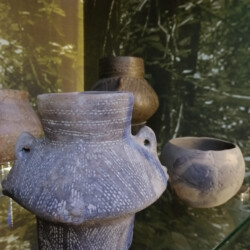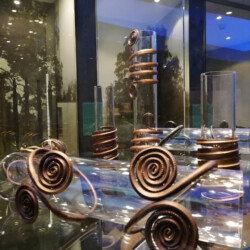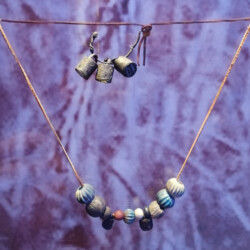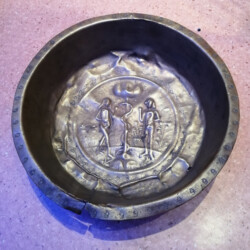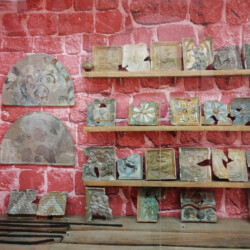From the earliest times, man has surrounded himself with beauty. He produced items that were not only useful for him, but also distinguished themselves by a high sense of aesthetics. This is reflected in the artefacts collected at the Archaeological and Ethnographic Museum in Łódź. Are the oldest tools made of flint tens of thousands of years ago not delightful? In addition to skill, their production required a great deal of spatial imagination. The need for beauty is evidenced by the appearance of hand-made clay vessels around 5,000 years ago. They were decorated with intricate lines, cuts, dots … To make these ornaments, man used whatever he had around him, ie twigs, straws or small flint tools.
Man also felt the need to decorate both his clothes and himself. Bronze armlets worn by men about 3,000 years ago, or various types of necklaces, make a huge impression. Clasps (brooches), pendants, pendants, rings were made of bronze, silver and gold, as well as vessels that were used for various ceremonies. Terra sigillata dishes, although made of clay, are like signed works of applied art – often the way an ornament is made is, in a way, a signature of the manufacturer, and the time of making such an item can be determined with an accuracy of several years!
Middle Ages – Dark Ages. Absolutely not! It was at this time that clay vessels were decorated so richly that almost no two were alike. It is also then that wonderful bowls, spells with scenes from the Old and New Testaments are created. At the turn of the 11th and 12th centuries, a ring was forged, which was discovered in Tum near Łęczyca. On it there is a sentence about the universal message „May you live happy, how long does the phoenix live”.
What else, but an expression of the need for beauty and aesthetics in the immediate surroundings in the 16th century, are stove tiles, usually colorful, richly decorated? Some show only floral and geometric ornaments, others were supposed to show the rank of the owner of the house in which the stove was located. They were decorated with family coats of arms, battle scenes, religious scenes, and portraits. The stove, in addition to its highly utilitarian role, was also an important element of equipment, interior decoration, as well as a carrier of a lot of information.
Every man-made item over the centuries; a vessel, a weapon or an ornament proves the great skills of the producers. In addition to the usefulness and usefulness of items, appearance and aesthetics were important.
Design in lodzkie – Exhibition – Archeologia
Od najdawniejszych czasów człowiek otaczał się pięknem. Wytwarzał przedmioty, które były nie tylko przydatne dla niego, ale też odznaczały się wysokim poczuciem estetyki. Wyrazem tego są zabytki zgromadzone w Muzeum Archeologicznym i Etnograficznym w Łodzi. Czy nie są zachwycające najstarsze narzędzia wykonane z krzemienia kilkadziesiąt tysięcy lat temu? Wytworzenie ich wymagało, oprócz umiejętności, dużej wyobraźni przestrzennej. O potrzebie piękna świadczy wygląd naczyń glinianych, ręcznie lepionych około 5 tysięcy lat temu. Ozdobiono je misternie kreskami, nacięciami, kropkami… Do wykonania tych ornamentów człowiek wykorzystywał to, co miał wokół siebie, czyli gałązek, słomek czy małych narzędzi krzemiennych.
Człowiek czuł także potrzebę przyozdabiania zarówno swojego ubioru jak i samego siebie. Ogromne wrażenie robią naramienniki z brązu noszone przez mężczyzn około 3 tysiące lat temu, czy różnego rodzaju naszyjniki. Z brązu, srebra, złota wyrabiano zapinki (fibule), wisiory, zawieszki, pierścionki…, a także naczynia, których używano do różnego rodzaju ceremonii. Naczynia terra sigillata, choć z gliny, są jak sygnowane dzieła sztuki użytkowej – nierzadko sposób wykonania ornamentu jest w pewnym sensie podpisem wytwórcy, a czas wytworzenia takiego przedmiotu można określić z dokładnością do kilkunastu lat!
Średniowiecze – wieki ciemne. Absolutnie nie! To w tym czasie naczynia gliniane zdobiono tak bogato, że niemal nie ma dwóch takich samych. Wtedy też powstają wspaniałe misy, czary ze scenami ze Starego i Nowego Testamentu. Na przełomie XI i XII wieku wykuto pierścień, który został odkryty w Tumie pod Łęczycą. Na nim właśnie umieszczono sentencję o jakże uniwersalnym przekazie „Obyś żył szczęśliwy, ile czasu żyje feniks”.
Czym innym, jak nie wyrażeniem potrzeby piękna, estetyki w najbliższym otoczeniu w XVI wieku, są kafle piecowe, najczęściej kolorowe, bogato zdobione? Jedne przedstawiają tylko ornamenty roślinne, geometryczne, zadaniem innych było pokazanie rangi właściciela domu, w którym piec się znajdował. Umieszczano na nich herby rodowe, sceny bitewne, religijne, portrety. Piec, oprócz roli wybitnie użytkowej, był też ważnym elementem wyposażenia, dekoracji wnętrza, a także nośnikiem wielu informacji.
Każdy przedmiot wytworzony przez człowieka na przestrzeni wieków; naczynie, broń czy ozdoba, świadczy o ogromnych umiejętnościach wytwórców. Oprócz użyteczności, przydatności przedmiotów, ważny był wygląd i estetyka.



